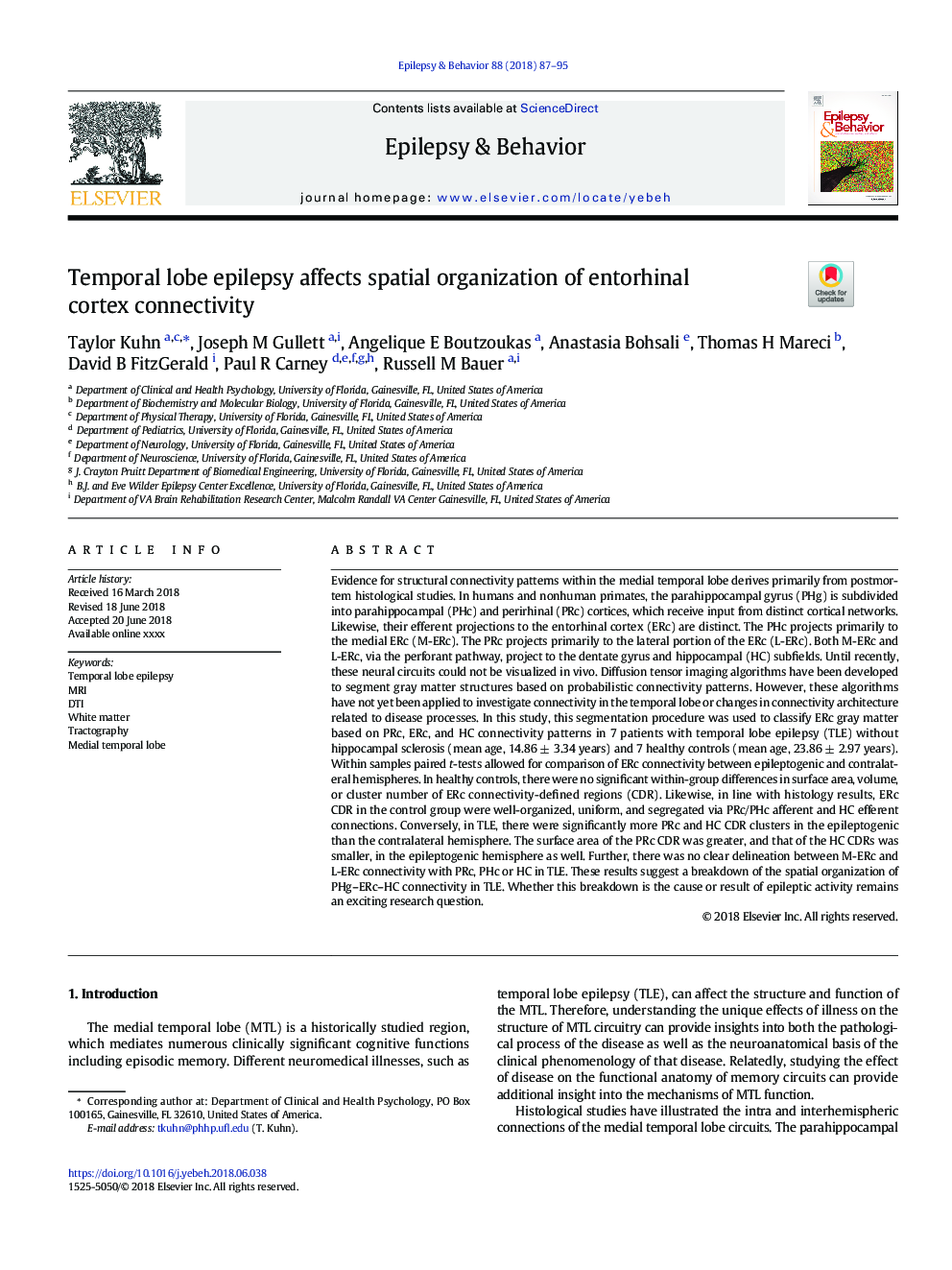| کد مقاله | کد نشریه | سال انتشار | مقاله انگلیسی | نسخه تمام متن |
|---|---|---|---|---|
| 10148602 | 1646613 | 2018 | 9 صفحه PDF | دانلود رایگان |
عنوان انگلیسی مقاله ISI
Temporal lobe epilepsy affects spatial organization of entorhinal cortex connectivity
ترجمه فارسی عنوان
صرع لوب صرع بر ساختار فضایی اتصال اتصال قشر انتورالین تاثیر می گذارد
دانلود مقاله + سفارش ترجمه
دانلود مقاله ISI انگلیسی
رایگان برای ایرانیان
کلمات کلیدی
موضوعات مرتبط
علوم زیستی و بیوفناوری
علم عصب شناسی
علوم اعصاب رفتاری
چکیده انگلیسی
Evidence for structural connectivity patterns within the medial temporal lobe derives primarily from postmortem histological studies. In humans and nonhuman primates, the parahippocampal gyrus (PHg) is subdivided into parahippocampal (PHc) and perirhinal (PRc) cortices, which receive input from distinct cortical networks. Likewise, their efferent projections to the entorhinal cortex (ERc) are distinct. The PHc projects primarily to the medial ERc (M-ERc). The PRc projects primarily to the lateral portion of the ERc (L-ERc). Both M-ERc and L-ERc, via the perforant pathway, project to the dentate gyrus and hippocampal (HC) subfields. Until recently, these neural circuits could not be visualized in vivo. Diffusion tensor imaging algorithms have been developed to segment gray matter structures based on probabilistic connectivity patterns. However, these algorithms have not yet been applied to investigate connectivity in the temporal lobe or changes in connectivity architecture related to disease processes. In this study, this segmentation procedure was used to classify ERc gray matter based on PRc, ERc, and HC connectivity patterns in 7 patients with temporal lobe epilepsy (TLE) without hippocampal sclerosis (mean age, 14.86â¯Â±â¯3.34â¯years) and 7 healthy controls (mean age, 23.86â¯Â±â¯2.97â¯years). Within samples paired t-tests allowed for comparison of ERc connectivity between epileptogenic and contralateral hemispheres. In healthy controls, there were no significant within-group differences in surface area, volume, or cluster number of ERc connectivity-defined regions (CDR). Likewise, in line with histology results, ERc CDR in the control group were well-organized, uniform, and segregated via PRc/PHc afferent and HC efferent connections. Conversely, in TLE, there were significantly more PRc and HC CDR clusters in the epileptogenic than the contralateral hemisphere. The surface area of the PRc CDR was greater, and that of the HC CDRs was smaller, in the epileptogenic hemisphere as well. Further, there was no clear delineation between M-ERc and L-ERc connectivity with PRc, PHc or HC in TLE. These results suggest a breakdown of the spatial organization of PHg-ERc-HC connectivity in TLE. Whether this breakdown is the cause or result of epileptic activity remains an exciting research question.
ناشر
Database: Elsevier - ScienceDirect (ساینس دایرکت)
Journal: Epilepsy & Behavior - Volume 88, November 2018, Pages 87-95
Journal: Epilepsy & Behavior - Volume 88, November 2018, Pages 87-95
نویسندگان
Taylor Kuhn, Joseph M Gullett, Angelique E Boutzoukas, Anastasia Bohsali, Thomas H Mareci, David B FitzGerald, Paul R Carney, Russell M Bauer,
